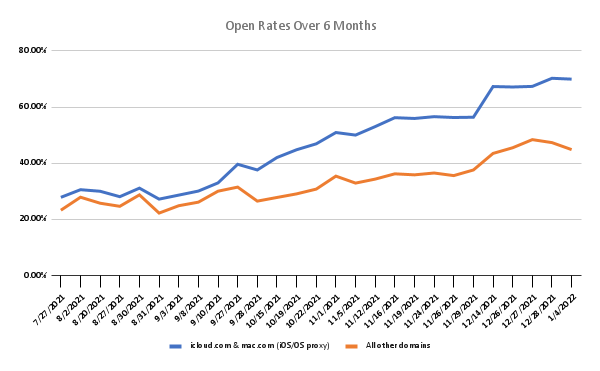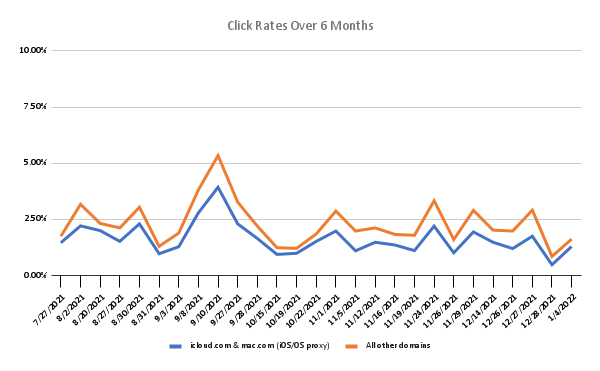Don’t panic. Before we dive into the iOS 15 Mail Privacy Protection (MPP) feature, we would like to make two points. First, this update does not mean doom for email. It’s still one of the most effective marketing tools and this update can help strengthen marketing efforts and strategies. Every day, more than 1 billion emails are deployed to inboxes. Second, like everything else in life, email marketing is changing. This is part of those changes and one that is likely to spread to other channels as well.
Response Labs is here to help guide you through these changes – where there is change, there is also opportunity. Keep in mind that this is an industry-level change and as of the end of 2021, no one has truly solved the issue of tracking opens/identifying iOS 15 customers from their larger email list. Once solved, Apple will likely make another update to combat the solution. At its core, Apple designed this feature set to protect the privacy of its customer’s email activity.
Now, let’s dive into MPP together:
What is MPP?
Apple’s iOS (iOS 15) and OS (Monterey) release includes a new privacy feature called “Mail Privacy Protection” (MPP). MPP hides a user’s IP address to prevent senders from linking that user’s email activity with their location or other online activity. It also prevents email opens from being tracked. Email opens are measured when images of an email download within a user’s email program. Then, it signals back to the server where the images are hosted by the email service provider (ESP), who then records the open IP address and location (based on the IP address – known as geotargeting) for reporting. With MPP enabled, Apple will preload the email images onto their own Apple servers and then serve it to the user. The data reported back to the ESP will only identify the Apple server “opening” the email and the server’s IP address and location—which is not the individual user’s.
To illustrate this, Response Labs used “iCloud.com” and “mac.com” email domains as a proxy (since we cannot identify individuals). We assume that the majority of these recipients are using an Apple mail app on iOS or OS. While not an exact science, this does provide some insight into the confirmation of the change taking effect. We see the impact by looking at the trend of the open rate vs that of the click rate. While there are more opens since September 2020 (around the rollout of iOS 15 MPP), the number of clicks have not changed. And with the non-http://icloud.com nor mac.com chart, you see a similar result.


The Effect of iOS 15 MPP On Existing Email Programs
The feature will only be available on Apple Mail applications across Apple devices (iPhone, iPad, iPod, Macbooks) no matter the email address hostname (i.e. gmail.com, yahoo.com, etc). However, MPP will not apply to those who view email through other apps like Gmail or Outlook, even if doing so on an Apple device. Before the update, Litmus reported Apple OS and iOS opens an account for 38% of email open volume, and at RL, we have seen results ranging from 15%-50%. Based on the customers who open an email, Apple users account for a significant population of users in many businesses.
MPP is not implemented by default. Users are offered the choice to opt-in when opening the Apple Mail app after the operating system update. A similar feature released earlier this year offered users a choice of preventing data from being tracked across mobile apps. Only about 4% of users opted out of that privacy feature and a similar result is expected with the MPP feature.
Therefore, email marketing as it operates today will be affected. All digital marketers must plan accordingly to address this change. Most affected by the lack of open, IP or location data are:
- Managing Email Suppression lists for inbox placement reputation management
- Subject line testing and Send Time Optimization (STO) to improve opens
- Automated campaigns triggered by email opens (or lapsed opens)
- Real-time personalization using location (like weather, local offers)
Managing Email Suppression Lists With iOS 15 MPP
Email suppression lists are a tool to protect the reputation of your Salesforce Marketing Cloud (SFMC) IP address from which emails are deployed. When emails are not opened or clicked over time, ESPs may determine the sender of that email as nefarious or irrelevant and mark all email from that source as Spam or blacklist it all together. Either of those actions would have a negative impact on a business directly, RL combats this by employing a series of tactics to manage sender reputation. One tactic is to suppress email addresses that have not opened or clicked an email over a period of time—typically between six months to a year. With opens no longer being recorded for the individual email address, we recommend changing the criteria to populate an email suppression list.
Other Data To Consider For Suppression Lists In Addition To Clicks
Clicks alone are not a valid solution. If you think about the difference between open rates and click-to-open rates, you know that suppressing those who do not click will result in an increased percentage of customers suppressed without actually improving inbox placement reputation. Therefore, we recommend evaluating and testing other criteria from data currently available, or potentially available, within SFMC.
Transaction Date & Time Data
The transaction data available in SFMC today varies by account and business. For the situations where we have transaction date and time available, we can begin to utilize it as part of the suppression criteria immediately. For example, the new criteria may include, “hasn’t completed a transaction in the past 12 months,” in addition to not having clicked an email in the past 12 months.
When it comes to data you do not have in SFMC, now is a good time to identify the best method for adding to your data team’s roadmap. Response Labs can help guide you here; otherwise, our general recommendation is to empower the marketing teams to decide what data to suppress or target. Basics to cover include the most recent transaction history data, though a processed orders feed is even better.
Cross-Channel Engagement
Data from channels like mobile and web offers opportunities to procure date and time stamps from engagement activity that can also be used for suppression/targeting criteria. Examples include last login, last app view, and last push engagement. As with the transaction data, the challenges will be how soon this data may be available in SFMC and what is the right mix for ensuring suppressing an appropriate amount of customers.
On the flip side, these same data points can also become excellent targeting tools to target your most engaged customers.
Unsubscribe Email Campaign
A more proactive approach is sending an email at regular intervals throughout the year that essentially asks the recipient, “Do you still want to receive email from us?” The target audience for this communication would be those that qualify under the new criteria. Recipients have the option of clicking “Yes” or “No” — the former keeps them active, and the latter marks them as unsubscribed. Determining what to do with those that don’t click either button is a business decision. Recipients typically run through this cycle three or four times before finally being marked ‘unsubscribed’ for inactivity.
Improving Email Marketing Performance with iOS 15 MPP
Open data plays a great role in many testing, optimization, and personalization practices for email marketing. With MPP, many of those practices will no longer be as reliable as they are today. We align with the perspective outlined by SFMC – focus on the data that matters most. A/B tests based on opens are still a viable testing strategy. In most cases, only 30+% of recipients are under Apple’s MPP; the remaining 70% is still a strong sample size to test. It is relatively safe to assume there will be an equal split of MPP recipients in randomized A/B test groups. Regular optimization based on opens is reliable, with a caveat that it likely reflects non-MPP/Apple subscribers. Unless there are documented studies that Apple users perform drastically differently than Android users, results are safe to lean on and inform decisions.
Success Metrics
Going deeper into the funnel of engagement metrics is a healthier and more realistic way of studying successful campaigns. Click tracking and conversion tracking are more critical, and more significant, than open rates because these interactions are tied closer to actual transactions. Utilizing clicks and conversions should become a higher priority moving forward. Communication to various internal leaders alerting them of this change should begin immediately.
Testing Criteria and Execution
Subject line testing is easy and helpful in improving open rates; however, there is an opportunity to create better emails by focusing on what drives a customer to click and convert. Building tests centered around transactional results offers a greater opportunity to learn what truly drives an action via email.
Behavioral and Preference Data
Location-based personalization will no longer be based in real-time when relying on where the email is opened. Instead, that personalization will need to come from the recipient’s profile data—first and/or zero-party—like the last store shopped or favorite store. Stronger, tighter loyalty programs will have this information. Companies will need to re-evaluate tools that use geo-targeting data (like LiveClicker); however, this is an opportunity to grow and adapt the marketing technology suite employed. Exploring opportunities to encourage customers to click on emails and travel out of them is paramount.
Transparency To Drive Engagement
Another method of driving customers to provide data for a better experience is to open up to them honestly. Be transparent as a brand as part of an email series. Pull back the curtain and go deeper into how brands use data to improve the shopping experience. This level of transparency also plays into the direction the industry is heading, as evidenced by this update from Apple. Other platforms expect to soon follow suit and implement privacy-protection features of their own.
Beginning the process of explaining how you are marketing to your customers now could be critical to future success.
The Importance of Retaining Customer Loyalty Moving Forward After iOS 15 MPP
The email marketing programs that succeed will be the ones that value their customers and their customers’ data first. There is a wealth of information on hand that can drive email marketing programs to higher levels. While push/SMS/social media are growth opportunities as well, email marketing will remain a major pillar in communicating with customers. While other agencies may be processing and learning how to address the current landscape shift, Response Labs is already well-positioned. Our philosophy of staying up-to-date on the latest trends, curating personalized content based on data, and transparent reporting and planning assures clients that they are in safe hands. Creating value for your customers in your email marketing efforts is key, or as Response Labs likes to say, “Make Every Message Matter”.


